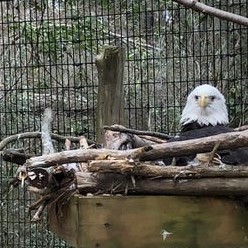Love is in the air with Oatland wildlife center birds
- Friends of Oatland
- Feb 11, 2021
- 3 min read
Eric Swanson | For Savannah Morning News
Published: Tuesday, February 9, 2021 at 6:30am EST
Musician John Paul Young once wrote “Love is in the air, everywhere I look around. Love is in the air, every sight and every sound.” As Valentine's Day approaches, the same could be said for the animals at Oatland Island Wildlife Center. While romantic love is debated as purely a human emotion, the rituals and behaviors of animals can be easily confused for love. So, since love is in the air, we thought we would take this opportunity to share some facts about the birds (but not the bees!) that call Oatland home.
Bird courtship rituals can look like human dating, with some species singing or dancing to impress a mate, others putting on flashy outfits by molting into bright feathers, still others provide tasty morsels to eat. The male Carolina wrens take things a bit further, asking females to move right in and start a family, building multiple nests to woo their partner. The building process and home showings display both their building skills as well as their excess energy —which cues potential mates that they are successful food foragers.
At Oatland, the Carolina wrens have been seen building their nests, and it won't be long until we see females diligently incubating eggs. Listen for their loud “teakettle, teakettle, teakettle” call next time you visit, and you might spot them!

Owls are winter nesters and hoot wildly from high perches to maintain and define territory, which is then controlled by a bonded pair. They work together to find a suitable place to lay eggs, like a tree cavity or an abandoned nest, the male striving to impress the female by bringing her small rodents to eat. Owl species cooperate to raise their young with each member of the pair providing incubation and food.
For years, our barred owl, Wahoohoo, has laid one or two eggs within a week of Valentine’s Day. With no male present in the enclosure the eggs are always infertile, but she still heeds the biological cue to lay an egg every winter. Listen for the easy-to-remember barred owl hooting, “Who cooks for you? Who cooks for you-all?” and the great horned owl making a deep but soft “hoo-ha HOO-hoo-hoo”.
If you have walked past the Oatland eagles recently you may have noticed two white eggs peeking up from their nest. Eagle eggs take approximately 35 days to incubate, with the female eagle minding the nest and tenderly turning the eggs with her beak. In the wild, many Southern bald eagle chicks hatch out near Valentine's Day. While our bald eagle pair, Arnold and Francesca, do appear to have bonded and tolerate each other's presence year-round (a rarity in the wild), the eggs laid every January have so far been found to be infertile. Whether the infertility is due to the human-made match or because of their poor balance due to past wing injuries, we can only speculate.
So, do bald eagles “love?” They do mate for life and return year after year to the same nest which takes a lot of commitment, so we will let you decide.
From flashy feathers to nest-building, a lot of bird behavior is driven by the biological urge to perpetuate their genes. In nature, if you have the skills to survive, your genes are valuable. While that simplification may not seem romantic for a pairing in human society, in the animal kingdom it is what matters the most. So this Valentine’s Day, though you may don your nicest clothes and secure a delicious meal for your partner, don’t forget to delight in the human experience of conversation and connection. And, if you’re looking for a great date idea, come check out the animal couples at Oatland Island Wildlife Center.
Eric Swanson is a naturalist at Oatland Island Wildlife Center. Learn more at oatlandisland.org or on Facebook at oatlandisland.








Commentaires